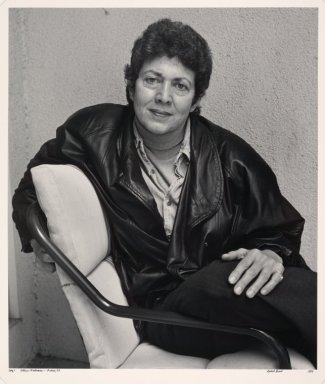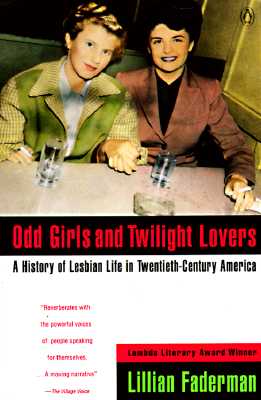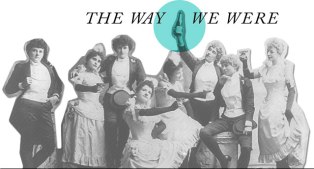June is LGBT Pride Month, so we’re celebrating all of our pride by feeding babies to lions! Just kidding, we’re talking about lesbian history, loosely defined as anything that happened in the 20th century or earlier, ’cause shit changes fast in these parts. We’re calling it The Way We Were, and we think you’re gonna like it. For a full index of all “The Way We Were” posts, click that graphic to the right there.
Previously:
1. Call For Submissions, by The Editors
2. Portraits of Lesbian Writers, 1987-1989, by Riese
3. The Way We Were Spotlight: Vita Sackville-West, by Sawyer
4. The Unaccountable Life of Charlie Brown, by Jemima
5. Before “The L Word,” There Was Lesbian Pulp Fiction, by Brittani
6. Read a Fucking Book: Odd Girls and Twilight Lovers, by Riese
![]()

Lillian Faderman. Fresno, CA. (1994) by Robert Giard
Because of the patriarchy and other looming dark forces at work in the universe, most queers grow up with no real awareness of their own history unless they seek out the information themselves or, you know, major in Queer Studies at Smith. (Or whatever it is you kids are calling it these days.)
I gave myself a crash-course in Queerness in 2006, tackling a formidable reading list that included novels, essay collections and non-fiction books like Bisexuality and the Eroticism of Everyday Life and The Girls Next Door. In the ensuing years, I started this website and, writing about lesbian issues every day, found myself giving myself mini-LGBT-history-crash-courses near-daily in order to write about LGBT news from a perspective of seeming authority.
When you’re immersed in this stuff all day every day, it can get legitimately frustrating, but also humbling, to be repeatedly reminded of how much I have left to learn. But also there’s no time! Then I saw the Canadian TV Show Bomb Girls, about women working in a bomb-making factory during World War II, and for some reason that show jumpstarted a full-fledged Herstory Phase, in which I am presently wallowing. My gateway book was arguably the most referenced book on the topic, Lillian Faderman’s Odd Girls and Twilight Lovers: A History of Lesbian Life in Twentieth-Century America. If you’re looking for a place to kick off an Independent Study, I think this is a good place to start.
The book was first published in 1991 by Columbia University Press, and a year later Viking Penguin purchased paperback rights to the book, which expired last year, inspiring a commemorative twentieth-anniversary re-issue from Columbia University Press, published on Valentine’s Day 2012. An interview with Faderman appears in the May/June issue of The Gay & Lesbian Review.
Faderman is a serious authority on lesbian culture and history, having penned heaps of books including To Believe in Women: What Lesbians Have Done For America – A History, Gay L. A.: A History of Sexual Outlaws, Power Politics, And Lipstick Lesbians (which I’m picking up from the library tomorrow! Yay!), Surpassing the Love of Men: Romantic Friendship and Love Between Women from the Renaissance to the Present and Chloe Plus Olivia : An Anthology of Lesbian Literature from the 17th Century to the Present.
Drawing from interviews, archive materials, journals, unpublished manuscripts, novels, pop culture artifacts and letters, Faderman traces lesbian history from the surprisingly unencumbered “romantic friendships” and “Boston Marriages” of the late 19th and early 20th centuries up through the Harlem Renaissance, two World Wars, the puritanical 50’s, the feminist movement, Lesbian Nation and the eventual emergence of Queer Nation and ACT UP! in the early 90s. It’s engaging, thorough, and fascinating.

There are so many things to learn about, you guys! So many things! I think we’re sold this idea that lesbians hid in their basements until the 70s, but that’s not true. In fact, it was information garnered from this book that inspired me to write my brilliant Ten Great Places To Meet Other Lesbians If You Have a Time Machine.
The bulk of the focus is on white middle-class cisgender lesbians, who, as the least disenfranchised and most populous group, produced the most documentation and source materials and also obviously had way more freedom and agency to live out their lesbianism than most anybody else. But Faderman consistently does strive to address the issues of working-class women and women of color, and states in her introduction that “for the chapters for which I could locate women to tell me about their experiences (beginning with the 1920s) I was anxious to do so, not only to round out the picture of lesbian life by a conscious attempt to look at class, age, ethnic and geographical diversity, but also to provide this study with their living voices.” She displays awareness throughout of the various conflicts between different groups of lesbians and of the racist, classist and ageist attitudes that characterized the dominant group consistently over time.
It’s chilling to read the back-and-forth between each triumph of queer culture and the inevitable backlash that followed it, and to trace the numerous societal forces that have conspired to make the world fear gay people — the near-arbitrariness of the modern Conservative religious push against LGBT rights comes into clear focus when you see it as just the latest opportunity for a ruling class to maintain or enhance their power at our expense. But the book isn’t about politics, really, and the most exciting part of the book is what survived and sometimes thrived despite all that, or because of it, and how that all led to where we are now.
Basically what I’m telling you is that if you’re as excited about The Way We Were as I am, and you haven’t read this book, you should read this fucking book. That’s all there is to it.




I love queer history books!
Just wanted to throw out that Leila Rupp’s “Sapphistries” book is an awesome attempt at a concise and global/historical look at women desiring/loving/having sex with other women, if you’re looking to add to your queer lady history reading list. :)
It tends to focus a lot on Europe/America because of access to historical records, but it also goes into different parts of Asia (including China, Japan, India, and the Middle East) and other areas when possible.
When in doubt “because of the patriarchy and other looming dark forces at work in the universe” is a great answer to just about any question
I have, in fact, read this fucking book. (Okay, well, maybe I stopped when I got to the lesbian separatists.) But v. interesting.
From Wikipedia, “She is now a professor of English at California State University, Fresno.” Holy fuck, she’s literally in my backyard… o__0
Oops, looks like I just bought another book…
This might be the second-best thing to come out of Bomb Girls, behind the turban craze that I hope will start anytime now.
Looooooved this book SO MUCH. A friend gave it to me saying that she thought I might like it. We hadn’t really talked for been friends before then.
Obvs now we are.
I just checked my uni library and we have four copies of it, I might just start spending my free time sauntering up and down that aisle like a creepy history book sex nerd. Yeah that’s a thing.
your name/icon give this comment such cool imagery. like a smart, sleek, very wise wolf wandering the stacks in search of more knowledge.
If I tell you that yes you are picturing me exactly right will you marry me?
Odd Girls and Twilight Lovers is a must-read for all you herstory buffs. I read this concurrently w/ Stone Butch Blues, another classic.
Thank you so so muuuuch. I constantly set out to write reasearchpapers zeroing in on queer women in North American History and spend literally weeeeeks combing the internets and libraries and every queer in a 2k radius for primary and secondary resources, and bloody hell its v. needle-haystack, PULLALTERNATIVELIFESTYLEHAIROUT-inducing, etc. Like serzzz, such a task. But this book is fantastic and I am totes hoping that during this theme month more queer history lit is highlighted :D
and now I have another book to add to my to-read list.
Thanks for posting this! Odd Girls is one of my favorites too, although I was kind of disappointed that it’s not always as well documented as it might be.
It’s one of the few books I’ve found that provides an overview of lesbians in the US in the 20th century (but as Riese points out, Faderman acknowledges that the documentary record often limits her to more elite, white women). However, Faderman also jumps to conclusions that aren’t fully justified by her footnotes, especially when she’s trying to make the case that that a person or goups of people liked women or identified as lesbians. While on a personal level I’m pleased to read that someone preferred being with women or identified as a lesbian, as a history buff I’m always a little concerned when queer historians don’t hold themselves to the documentary standards of other writers, since this ultimately undermines their credibility in the larger academic world.
But fwiw, if you like early 20th century women’s history, Blanche Wiesen Cook’s two-volume series on Eleanor Roosevelt is fantastic. Cook created a stir when these books came out because she suggested that Eleanor had a long-term relationship with Lorena Hickock, an AP reporter, and that many of Eleanor’s closest friends were also lesbians. Critics had a harder time with this than with Faderman’s books (even though Cook is also an out lesbian) because Cook’s research and conclusions are so well documented.
http://www.nytimes.com/books/99/07/04/specials/cook.html
Anyways, just my 2 cents worth…
something to add to the list!
Pingback: Odd Girls and Twilight Lovers – Odd Planet
Pingback: Odd Girls and Twilight Lovers (1991) – Odd Planet
Pingback: Odd Girls and Twilight Lovers (1991) by Lillian Faderman - Odd Planet